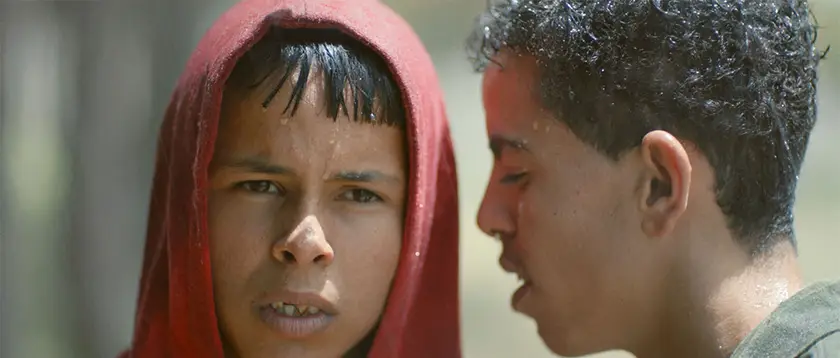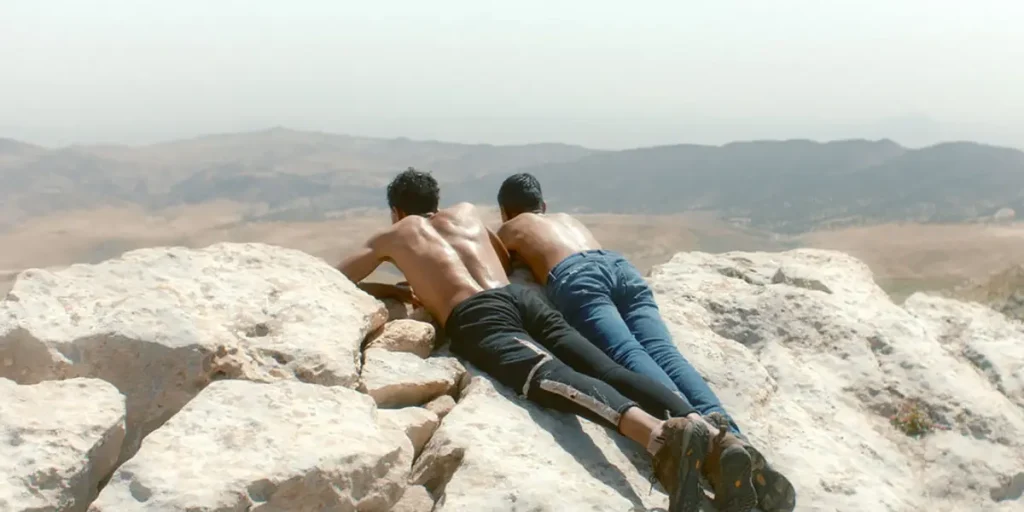Based on a disturbing true story, Red Path dabbles in magic realism to explore the impact of terrorism on Tunisian children.
Director: Lotfi Achour
Original Title: Les Enfants Rouges
Genre: Drama
Run Time: 101′
U.K. Release: June 20, 2025
U.S. Release: TBA
Where to Watch: In select U.K. cinemas
When retelling the story of a real-life tragedy, it seems the filmmaker’s default modus operandi is clarity and veracity. The strictly linear narrative of Denis Villeneuve’s Polytechnique was crafted from the testimonies of the victims it depicted, while Paul Greengrass’s United 93 fills some blanks but is anchored by the facts. It’s easy to see the uncontroversial appeal of such a strategy, which is what makes Lotfi Achour’s Red Path, based on the 2015 killing of teenager Mabrouk Soltani, a refreshingly daring project.
Here the Tunisian playwright-cum-director throws in a dash of magic realism, making for a more sensorial depiction of the effects of extremism on children.
Serving as a form of character study, whereby Achraf (Helali) and the two other youngsters at its core represent the millions of youths affected by conflict, Red Path is decidedly light on plot. It takes place in a post-Arab Spring context, after the overthrow of dictator Zine El Abidine Ben Ali and with Tunisia’s road to democracy laid out. But geographically we find ourselves far from the halls of power in Tunis and closer to the Algerian border, in the rural lands where ISIS insurgency has taken hold.
Accosted by a group of jihadists while herding goats up Mghila Mountain, where the real incident occurred, Achraf witnesses the brutal murder of his older cousin Nizar (Yassine Samouni), whom the terrorists accuse of informing on them to the government. Already traumatised, he is instructed to take home his cousin’s severed head as a macabre punishment and warning to his family. What follows is a physical journey, to recover the rest of the deceased’s remains and observe the appropriate funeral rites, and an emotional one, navigating the horror of a child taken before his time in the most barbaric circumstances.

After the initial ordeal, itself depicted from Achraf’s subjective point of view and riddled with obfuscation, the film’s fantastical elements seep in as Achraf begins to communicate with the ghost of Nizar, who helps him through his grief. Wojciech Staron’s cinematography supplies the ethereal atmosphere, his daytime scenes using high-key lighting that gives the images an overexposed effect; the glow of the white mountains is almost blinding. Not afraid to get up close and personal, he shoots his human subjects invasively, to the point of occasionally employing the POV technique seen in last year’s Nickel Boys to achieve a sense of dissociation as Achraf tries to return to normal life.
This is a symbolically rich work, the most obvious and imposing motif being the bloodied bag in which Achraf keeps Nizar’s head. It’s dragged around like the proverbial albatross, ever present and weighing heavily, a symbol of the unspeakable violence only the protagonist witnessed, a burden that cannot be shared. There’s the recurring mention of water, a valuable commodity in an arid landscape but also speaking to the young characters’ escapism. And then we have the baby goat, a fellow survivor of the attack and a reminder of Achraf’s lost innocence; it makes for moving, if a little unsubtle, imagery.
The context of Tunisia’s war against terrorism is only lightly touched upon and some audiences abroad may struggle to grasp its significance, but that’s not a major hindrance in a film predicated not on its politics, but on the strength of its characters and performers. Helali, in his debut, brings both stoicism and vulnerability to Achraf, and he and Samouni are completely credible as cousins and lifelong friends. Additional credit must go to Wided Dabebi as Rahma, the former object of Nizar’s desires and a confidante of Achraf; their interplay is tender and touching, at once demonstrating the kind of maturity such victims of conflict are forced to develop and reminding us with their playful repartee that they are, after all, children.
A brief postscript reasserts that there is truth at the heart of the story, before offering information on further, equally upsetting events that unfolded in the years following Soltani’s murder. This second part is a sobering revelation, but one that contrasts with the film’s own mildly hopeful denouement. And that’s where Achour’s toying with fantasy and imagination allows us a reprieve: he suggests that maybe, just this once, we can believe in another ending, another future for the young people of these beleaguered communities. In doing so, he offers his subjects something resembling life beyond death.
Red Path: Movie Plot & Recap
Synopsis:
After a terrifying ordeal at the hands of violent extremists leads, a young Tunisian grapples with the death of his cousin and the trauma and lost innocence it entails. As if that weren’t enough to deal with, he is forced to join the men of the family in retracing his steps to recover the body, opening fresh psychological wounds.
Pros:
- Outstanding performances from the film’s young leads
- Unusual cinematography bolsters the magic realist tone
- An empathetic look at childhood trauma
Cons:
- A little heavy handed with its themes and symbolism
- Foreign audiences may struggle to place the film in context
Red Path will be released in select UK cinemas on June 20, 2025.

